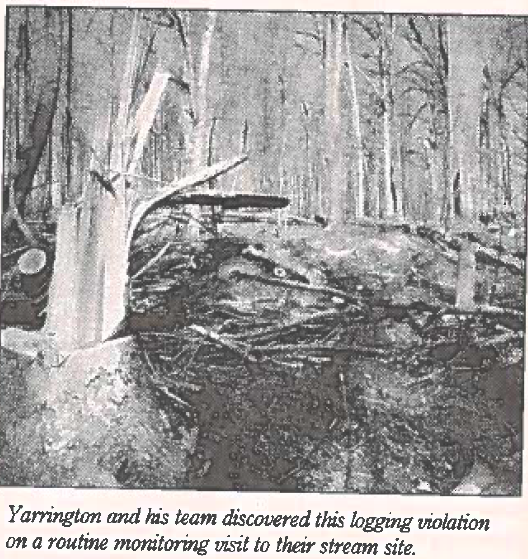By Pete Yarrington, long-time WQM volunteer
Editor’s note: This article was adapted from Pete Yarrington’s testimony at the May 17, 2001 Nature Forward (then Audubon Naturalist Society) presentation to the Montgomery County Planning Board. This article was originally published in the September, 2001 Naturalist Quarterly publication.
ANS water quality monitoring site #29 is located on a small, unnamed tributary of Rocky Gorge Reservoir on the Patuxent River in a large wooded area just inside Montgomery County’s Ednor Park. Monitoring at the site began in 1996 and I have been on the monitoring team there since that time. I have always felt that our site has special importance—it’s waters flow into the Patuxent’s water supply reservoir, I grew up fishing the upper Patuxent for trout and bass, I still do, and I am encouraging my young son to join me.
An important benefit of participating in the ANS monitoring program is the training ANS gives its volunteers— the data we record are collected in a uniform manner and are considered to be of high enough quality to be used by county and state Environmental Protection officials. An aquatic ecologist by training, I have done extensive habitat assessment and biological monitoring of local streams using macroinvertebrates and fish as indicators. Despite this previous work, I learn new things from our ANS field work virtually every time we go out.
It’s rewarding, too, to know that we are serving as environmental “watchdogs.” We know that outdoor areas that receive visible attention on a regular basis are a little less likely to be targets of abuse, and that we can help identify problems that occur before they have a chance to fester.
An incident that began during our monitoring session in February brings the “watch dog” aspect of our monitoring work into very sharp focus. Upon arriving at our stream on February 11,2001 we found that a very large area around our once-forested site had been basically leveled of trees—it looked a lot like “clearcut” pictures you see of western logging operations. Very few trees were left standing, and vegetation was removed right down to the stream edge. In fact, the stream immediately downstream from our site had been reduced to a small flow through mud, due to runoff from the work area.
Despite the fact that the area cleared of trees was privately owned, according to maps obtained from the Maryland National Capital Park and Planning Commission (MNCPPC), it seemed to our team that the removal of bankside vegetation over such a large area was probably a water quality protection violation of some sort, especially considering the water supply reservoir just downstream. We returned later that day with a camera, and wrote a letter with attached pictures to Blair Ewing of the Montgomery County Council, with copies to the MNCPPC. MNCPPC directed us to Bruce Payne, who works in enforcement of sedimentation and stormwater management regulations with Montgomery County. The site of the tree cutting, which was later measured at more than forty acres in size, was visited very quickly by both county and state inspectors, who determined that a violation of requirements had indeed occurred.
A recent telephone conversation with Payne indicated that a settlement with the landowner and the tree-cutting company is currently being pursued. The settlement will likely include a series of mitigative measures, including modification of access roads to the work site, removal of debris from the stream channel, and reforestation of the stream’s riparian borders. Indications are that the costs of this mitigative work will exceed profits made from the sale of the wood.
This forest destruction may have gone unnoticed, were it not for our monitoring visit, for the site is largely invisible to the public due to the surrounding wooded area and hilly terrain. I also don’t know if authorities would have followed up if we hadn’t pursued the issue. But I can tell you that while this isn’t the kind of thing we like to find in our monitoring activities. I am certainly glad that we went out that day in February.

